Alleviation: An International Journal of Nutrition, Gender & Social Development, ISSN 2348-9340
Volume 2, Number 2 (2015) : 1-7
©Arya PG College, Panipat & Business Press India Publication, Delhi
www.aryapgcollege.com, www.apcjournals.com
Designing of Cushion Covers with the Most Preferred Phulkari Motifs Using Four Implementation Techniques
Mrs. Sandeep Reen
Assistant Professor, Guru Nanak Girls College, Yamunanagar (Haryana), India
E-mail: sandeepreen18@gmail.com
Introduction
Since ages, man has been decorating textiles using different techniques like dying, printing, painting and embroidery. Among these, embroidery is the richest mode of expressing emotions and aesthetic attributes. The excitements of creative accomplishments are one of the life’s most satisfying experiences. Though the exact origin of art of embroidery is not known, yet it certainly dates back to remote ages as evidenced by ancient sculptures and is thought to have originated in the eastern region of the world.
Each state of India has its own characteristic embroidery feature, out of which one most elegant embroidery is phulkari of Punjab. Its fairest folk art is appreciated not only throughout India but is adorned all over the world. By the end of 19th century, phulkari and baghs had found a large market in Europe and America also.
The phulkari was not only an exquisite work of traditional art but an intimate ingredient of social life in Punjab. Phulkari work is very laborious and slow and art is acquired with difficulty. Different formulas of various patterns are handed over from mother to daughter and friend to friend.
Phulkari and baghs had been used as palang posh (Bed-covers) and mej posh (Table covers), these being occasionally taken out in honour of a valued guest. These embroidered pieces have now become a rarity change brought about by social and economic development of state. For carrying out the changes, phulkari embroidery has been done by various techniques.
Hand embroidery gives a new look to the articles and hand work is very slow and laborious. Today the machine embroidery has become popular. On the other side, hand printing and painting on fabric are the arts for which Indian textiles have been chiefly famed abroad.
Textile painting and printing forms important and integral part of textile coloring. The present study was a comparative study of various fabric implementation techniques (Hand embroidery, machine embroidery, hand painting and screen printing) applied to phulkari motifs and to design and construct cushion covers with fabric implementation techniques and compare these techniques. The main objectives kept in mind were:
1) To know about different preferences of respondents regarding phulkari motifs to be used in designing cushion covers.
2) To develop selected motifs on cushion covers using four different placements.
3) To evaluate cushion covers and to find out the best suited techniques used on common motifs.
Methodology
The present study was conducted for imparting a new look to the traditional embroidery of phulkari and to find out the best implementation techniques that is hand embroidery, machine embroidery, hand painting and screen painting.
The information was collected from the respondents regarding their tastes and preferences for different traditional motifs of phulkari, material to be used for making cushion covers, threads to be used, color and color schemes and different placements. Finally cushion covers were prepared using most preferred phulkari motifs and selected placements using different techniques. The evaluation of these cushion covers was done by group of judges on the basis of their appeal and workmanship. The cushion cover with highest score was selected as a best piece.
Results and Discussion
Most Preferred Motifs for Fabric Implementation Techniques
It can be seen from the Table/Fig 1 that motif No. 33 according to respondents had scored highest marks which was selected by majority as a best motif.
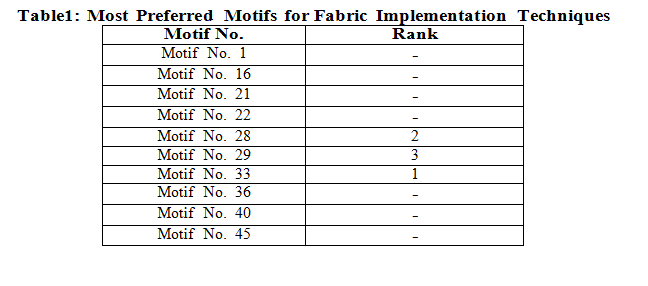
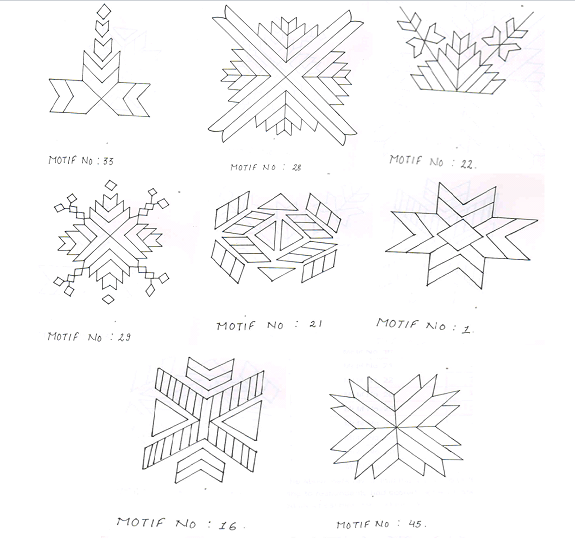
Fig 1: Most Preferred Motifs for Fabric Implementation Techniques
Preference for Different Types of Material for Making the Cushion Covers Table 2 shows that casement material was ranked on first position by the respondents, followed by glaze cotton, jute, terricot and silk.
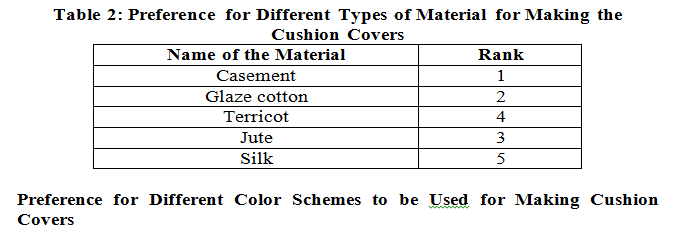
It is depicted in the Table 3 that primary color scheme got highest marks and was selected as best color scheme while secondary and quaternary respectively stood on second and third rank and then the tertiary color scheme got very little preference and stood on fourth rank.
It was found that majority of the respondents preferred primary color scheme because they felt that all primary colors were bright enough and would produce good results.
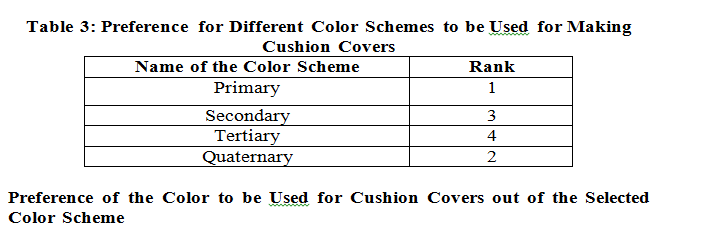
It is highlighted in the Table 4 that red color got the first preference by the respondents and stood on first rank, yellow got the second preference from the respondents, followed by blue color preferred by very few.

Red and yellow got the highest preference because of the bright and beautiful effects of these colors. So red and yellow colors were used further in the study.
Most Preferred Four Placements Used for Making Cushion Covers Using Different Techniques
Different placements were drawn and shown to the respondents. The most preferred placements were further applied in different techniques for making cushion covers. Cushion cover made with fabric implementation technique with placement number 15 according to the respondents had scored highest marks and was selected as the best implementation technique (Table 5 & Figs 2, 3 and 4).
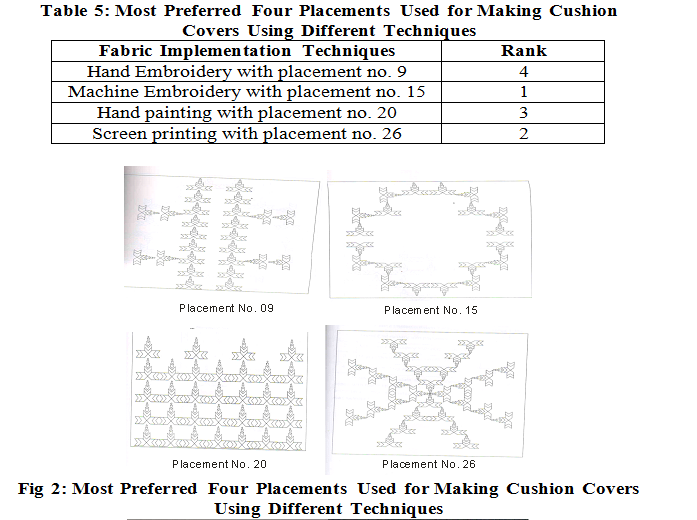
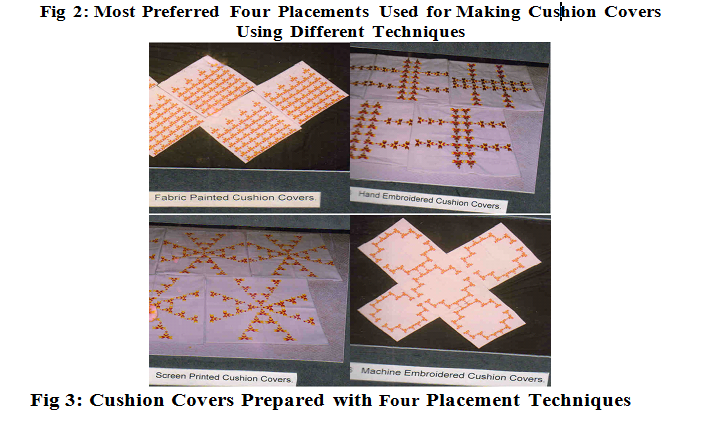
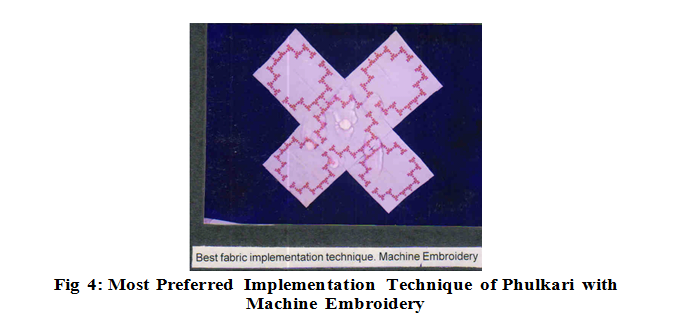
Conclusions
Phulkari is the finest of all the folk arts of Punjab. With the changes in the economy and social structure of Punjab, Phulkari has become out of fashion. The present study aimed at imparting a new look to the traditional embroidery of phulkari. By making slight modifications in our traditional embroidery, we can introduce some techniques of embroidery for fashion conscious people. Thus, we can reach the height of fashion even by keeping our feet on traditional ground. With the help of new changes and ideas, this traditional embroidery can also get the attention of new generation.
References
Bawa R (1997) Designing and Construction of Suits Using Phulkari for Formal Wear and Development of Paper Patterns. Unpublished Master’s Dissertation, Kurukshetra University, Kurukshetra.
Dongerkerry KS (1954) Romance of Indian Embroidery. Mumbai: Thakur Co. Ltd.
Mehta S (1999) A Study on Combination of Tie and Dye with Three Traditional Embroideries of India. Unpublished Master’s Dissertation, Kurukshetra University, Kurukshetra.
Naik S (1996) Traditional Embroideries of India. New Delhi: Publishing Co – operation

